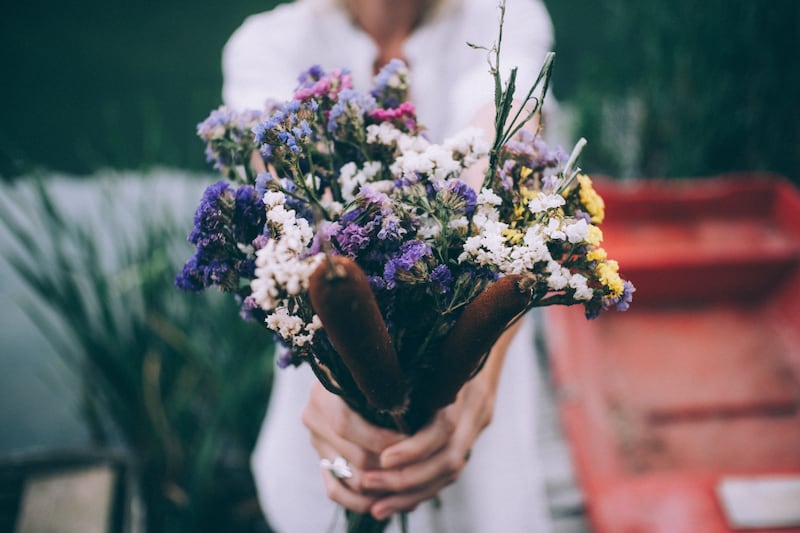Q: My daughter has just booked her wedding for October and feels dried flowers are more sustainable for the bouquets/ buttonholes/pew ends etc. I would like to do this other than the bouquets. Is there enough time to plant next spring, grow and dry by October? I’ve gardened all my life and tried drying hydrangea heads on a few occasions, but not very successfully. Is the time scale too short and if not can you recommend any particular flowers that will hold their colour? She hasn’t picked her bridesmaids dresses so I haven’t a particular colour in mind yet. MB, Dublin
A: In recent years, dried flowers or “everlastings” have cast off their slightly musty, old-fashioned 1970s vibe to become fashionable with a younger generation, their popularity driven by the desire for a more planet-friendly alternative to imported, out-of-season, fresh-cut flowers. The cruel irony is that this has very often resulted in imported bunches of intensively chemically-treated (and often chemically-dyed/spray-painted) dried flowers being sold to an unwitting public as the environmentally friendly option, when in fact, they’re anything but. So it’s brilliant that you’re planning to grow and dry your own.
The great news is that you still have plenty of time to do so for your daughter’s October wedding if you concentrate on some of the very fast-growing, ultra-productive annual varieties. Most can be air-dried as simple bunches secured with an elastic band and then hung upside down on a miniature ‘washing line’ for a couple of weeks in a dry, dark room, attic space or airy cupboard. Other flowers such as hydrangeas are better dried using what’s known as the evaporation method, where the cut stems are placed in a vase with just a small amount of water and slowly left to dry out over time. Bear in mind that you’ll also need to store your dried flowers somewhere dry and dark indoors until needed.
Top of my list to sow this spring would be the very trendy strawflower (Xerochrysum bracteatum/Helichrysum bracteatum), a half-hardy annual whose stiff, daisy-like flowers come in almost every shade bar blue); the half-hardy annual statice (Limonium sinuatum), a brilliant dried “filler” for bouquets and arrangements; and larkspur or Consolida ajacis, the hardy annual cousin of the delphinium with tall slender flower spires in shades of blue, white and pink. Many varieties of amaranthus (for example the trailing, coral flowers of Amaranthus “Coral Fountain” and lime-green Amaranthus “Green Tassels”) also dry very well and keep their colour, as do the intricately pretty flowers of Love-in-a-Mist (Nigella); Helipterum, and cornflowers (Centaurea cyanus).
Some dried flowers of ornamental grasses will also add a nice contemporary touch. Suitable varieties include the annual bunny’s tail (Lagurus ovatus) and a few very fast-growing perennial species such as quaking grass (Briza media “Limouzi”) and the Chinese fountain grass, Pennisetum villosum “Cream Falls”.

All of the above can be raised from seed this spring, bearing in mind that you’ll need to sow the half-hardy and perernnial varieties under cover and with gentle heat in a bright frost-free spot. Recommended Irish seed suppliers include seedaholic.com and mrmiddleton.com
If you or a generous gardening friend grow any of the following perennials then these are also great for drying: burnet (Sanguisorba), masterwort (Astrantia), lady’s mantle (Alchemilla), globe thistle (Echinops) and yarrow (Achillea). Dried flowers aside, it’s also very possible that late-flowering species such as dahlia, crocosmia and agapanthus (all of which are also suitable for drying) will still be in flower in October. There’s also plenty of suitable fresh wild material that can be responsibly foraged in October and put to great use including wild ferns, wild rosehips, teasels and the autumnal foliage of many deciduous specie of trees.
Finally, for lots more practical tips and inspiration on dried flowers, check out the Instagram feed of the UK-based gardeners and authors Bex Partridge (@botanical_tales) and Carolyn Dunster (@carolynrdunster), both of whom have written great books on the subject.




















